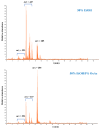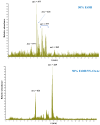Simultaneous High-Performance Recovery and Extended Acid-Catalyzed Hydrolysis of Oleuropein and Flavonoid Glycosides of Olive (Olea europaea) Leaves: Hydrothermal versus Ethanol Organosolv Treatment
- PMID: 39063062
- PMCID: PMC11277424
- DOI: 10.3390/ijms25147820
Simultaneous High-Performance Recovery and Extended Acid-Catalyzed Hydrolysis of Oleuropein and Flavonoid Glycosides of Olive (Olea europaea) Leaves: Hydrothermal versus Ethanol Organosolv Treatment
Abstract
Olive leaves (OLLs) are an exceptional bioresource of natural polyphenols with proven antioxidant activity, yet the applicability of OLL extracts is constrained by the relatively high polarity of the major polyphenols, which occur as glycosides. To overcome this limitation, OLLs were subjected to both hydrothermal and ethanol organosolv treatments, fostered by acid catalysis to solicit in parallel increased polyphenol recovery and polyphenol modification into simpler, lower-polarity substances. After an initial screening of natural organic acids, oxalic acid (OxAc) was found to be the highest-performing catalyst. The extraction behavior using OxAc-catalyzed hydrothermal and ethanol organosolv treatments was appraised using kinetics, while treatment optimization was accomplished by deploying response-surface methodology. The comparative assessment of the composition extracts produced under optimal conditions of residence time and temperature was performed with liquid chromatography-tandem mass spectrometry and revealed that OLLs treated with 50% ethanol/1.5% HCl suffered extensive oleuropein and flavone glycoside hydrolysis, affording almost 23.4 mg hydroxytyrosol and 2 mg luteolin per g dry weight. On the other hand, hydrothermal treatment with 5% OxAc provided 20.2 and 0.12 mg of hydroxytyrosol and luteolin, respectively. Apigenin was in all cases a minor extract constituent. The study presented herein demonstrated for the first time the usefulness of using a natural, food-grade organic acid to perform such a task, yet further investigation is needed to maximize the desired effect.
Keywords: acid hydrolysis; antioxidants; olive leaves; oxalic acid; polyphenols.
Conflict of interest statement
The authors declare no conflicts of interest.
Figures









Similar articles
-
Optimisation of the extraction of olive (Olea europaea) leaf phenolics using water/ethanol-based solvent systems and response surface methodology.Anal Bioanal Chem. 2008 Nov;392(5):977-85. doi: 10.1007/s00216-008-2353-9. Epub 2008 Sep 2. Anal Bioanal Chem. 2008. PMID: 18762919
-
Use of olive (Olea europaea L.) leaves as beer ingredient, and their influence on beer chemical composition and antioxidant activity.J Food Sci. 2020 Aug;85(8):2278-2285. doi: 10.1111/1750-3841.15318. Epub 2020 Jul 11. J Food Sci. 2020. PMID: 32652593
-
Selective ultrasound-enhanced enzymatic hydrolysis of oleuropein to its aglycon in olive (Olea europaea L.) leaf extracts.Food Chem. 2017 Apr 1;220:282-288. doi: 10.1016/j.foodchem.2016.10.011. Epub 2016 Oct 4. Food Chem. 2017. PMID: 27855900
-
Oleuropein: Chemistry, extraction techniques and nutraceutical perspectives-An update.Crit Rev Food Sci Nutr. 2024;64(27):9933-9954. doi: 10.1080/10408398.2023.2218495. Epub 2023 Jun 5. Crit Rev Food Sci Nutr. 2024. PMID: 37272499 Review.
-
Polyphenols benefits of olive leaf (Olea europaea L) to human health.Nutr Hosp. 2014 Dec 17;31(3):1427-33. doi: 10.3305/nh.2015.31.3.8400. Nutr Hosp. 2014. PMID: 25726243 Review.
Cited by
-
Enhancing Set-Type Yoghurt With Olive Leaf Extract: A Comparison of Powdered Addition and Surface Spraying on Quality, Functionality, and Sensory Attributes.Food Sci Nutr. 2025 May 13;13(5):e70273. doi: 10.1002/fsn3.70273. eCollection 2025 May. Food Sci Nutr. 2025. PMID: 40365037 Free PMC article.
-
Innovative strategy for full-scale polar components explicition and ultrasonic-assisted optimization of Astragalus membranaceus flower.Ultrason Sonochem. 2025 Mar;114:107238. doi: 10.1016/j.ultsonch.2025.107238. Epub 2025 Jan 24. Ultrason Sonochem. 2025. PMID: 39884109 Free PMC article.
References
-
- Ouro-Salim O., Guarnieri P. Circular economy of food waste: A literature review. Environ. Qual. Manag. 2022;32:225–242. doi: 10.1002/tqem.21836. - DOI
-
- Rațu R.N., Veleșcu I.D., Stoica F., Usturoi A., Arsenoaia V.N., Crivei I.C., Postolache A.N., Lipșa F.D., Filipov F., Florea A.M. Application of agri-food by-products in the food industry. Agriculture. 2023;13:1559. doi: 10.3390/agriculture13081559. - DOI
MeSH terms
Substances
LinkOut - more resources
Full Text Sources

